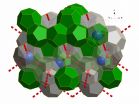(Press-News.org) Clathrates are now known to store enormous quantities of methane and other gases in the permafrost as well as in vast sediment layers hundreds of metres deep at the bottom of the ocean floor. Their potential decomposition could therefore have significant consequences for our planet, making an improved understanding of their properties a key priority.
In a paper published in Nature this week, scientists from the University of Göttingen and the Institut Laue Langevin (ILL) report on the first empty clathrate of this type, consisting of a framework of water molecules with all guest molecules removed. Long thought to be purely hypothetical, this empty clathrate plays an important role in our understanding of the physical chemistry of gas hydrates. Such research could help ease the flow of gas and oil through pipelines in low temperature environments, and open up untapped reservoirs of natural gas on the ocean floor.
In order to create the sample of Ice XVI, the researchers constructed a clathrate filled with molecules of neon gas, which they then removed by careful pumping at low temperatures. Using small atoms such as those of neon gas allowed the clathrate to be emptied without compromising its fragile structure.
In order to achieve this, the neon clathrate was pumped in a vacuum at temperatures in the region of 140° K, while neutron diffraction data was taken using the ILL's state-of-the-art D20 diffractometer. The images obtained allowed them to confirm when the clathrate had been fully emptied, and provided a complete picture of the resulting structure.
As a stable solid composed entirely of molecules of H2O, the empty clathrate also represents a new phase of ice. Ice XVI is the 17th discovered form of ice, and is the least dense of all known crystalline forms of water. It is also predicted to be a stable low-temperature configuration of water at negative pressures (the equivalent of tension - the opposite of compressive positive pressures), and is so far the only experimentally-obtained form of ice to have a clathrate configuration.
As the empty clathrate is used as a reference frame for numerous molecular simulations, scientists have up until now relied on approximate theoretical models to underpin their work. The empty clathrate framework obtained at the ILL will now allow for the accurate determination of its fundamental structural and thermodynamic properties. The ability to create and observe such empty clathrates has the potential to considerably improve our understanding of these compounds when they are filled with gas.
According to the 2007 World Energy Outlook, the total amount of methane stored within clathrates on the ocean floor far exceeds the economically exploitable reserves of "conventional" carbon in the form of coal, petrol or natural gas left on Earth. These reservoirs are difficult to exploit at present but form a domain of intense ongoing research.
Thomas Hansen, one of the study authors and instrument scientist on D20 at the ILL, says: "It is important to note that clathrates could also be formed with carbon dioxide gas which would create stable compounds on the ocean floor. This means there is a possibility we could extract methane and convert it to useful energy, and replace it with the CO2. In other words, we could pump CO2 down to the ocean floor as a replacement for the methane in the gas hydrates. The challenges involved would naturally be large and the feasibility has been called into question, but it remains an extremely intriguing possibility worth exploring.
Hansen adds: "My co-authors Andrzej Falenty and Werner F Kuhs from the University of Göttingen are both members of the SUGAR project funded by the German government, whose aim is to explore the scientific, technical and economic possibilities of such an undertaking. Similar activities are currently underway in Japan, China, India and elsewhere."
Helmut Schober, ILL Science Director, said: "Empty clathrate hydrates have for many years been the subject of intense scientific speculation, as their very existence was relatively uncertain. The present discovery definitively resolves this speculation, and provides us with a new jewel in the fascinating treasure chest of ice phases. Predicting the properties of ice XVI will be a benchmark for any model that pretends to describe the physics of water. This in itself is a tremendous step forward. It is via this understanding that we hopefully will also advance on the surrounding questions related to energy."
An area where clathrate research is of more immediate benefit is in the maintenance of pipelines where gas is transported at high pressures and low temperatures. These conditions can lead to the production of gas hydrates within the pipes, which in turn form substantial blockages, the prevention of which costs industry approximately $500 million a year worldwide. Given the high international economic impact of such pipelines, this represents a significant cost factor that further research on clathrate properties can help reduce.
INFORMATION:
CAMBRIDGE, MA -- Using a gene-editing system originally developed to delete specific genes, MIT researchers have now shown that they can reliably turn on any gene of their choosing in living cells.
This new application for the CRISPR/Cas9 gene-editing system should allow scientists to more easily determine the function of individual genes, according to Feng Zhang, the W.M. Keck Career Development Professor in Biomedical Engineering in MIT's Departments of Brain and Cognitive Sciences and Biological Engineering, and a member of the Broad Institute and MIT's McGovern Institute ...
Anticipated changes in climate will push West Coast marine species from sharks to salmon northward an average of 30 kilometers per decade, shaking up fish communities and shifting fishing grounds, according to a new study published in Progress in Oceanography.
The study suggests that shifting species will likely move into the habitats of other marine life to the north, especially in the Gulf of Alaska and Bering Sea. Some will simultaneously disappear from areas at the southern end of their ranges, especially off Oregon and California.
"As the climate warms, the species ...
For the firefighters and rescue workers conducting the rescue and cleanup operations at Ground Zero from September 2001 to May 2002, exposure to hazardous airborne particles led to a disturbing "WTC cough" -- obstructed airways and inflammatory bronchial hyperactivity -- and acute inflammation of the lungs. At the time, bronchoscopy, the insertion of a fiber optic bronchoscope into the lung, was the only way to obtain lung samples. But this method is highly invasive and impractical for screening large populations.
That motivated Prof. Elizabeth Fireman of Tel Aviv University's ...
There are pros and cons to the support that victimized teenagers get from their friends. Depending on the type of aggression they are exposed to, such support may reduce youth's risk for depressive symptoms. On the other hand, it may make some young people follow the delinquent example of their friends, says a team of researchers from the University of Kansas in the US, led by John Cooley. Their findings are published in Springer's Journal of Psychopathology and Behavioral Assessment.
Adolescence is an important time during which youth establish their social identity. ...
Patients with heart disease who receive transfusions during surgeries do just as well with smaller amounts of blood and face no greater risk of dying from other diseases than patients who received more blood, according to a new Rutgers study.
The research, published in the journal Lancet, measures overall mortality and mortality from cardiovascular disease, cancer and severe infection, and offers new validation to a recent trend toward smaller transfusions.
For the study, led by Jeffrey Carson, chief of the Division of Internal Medicine at Rutgers Robert Wood Johnson ...
A class of drug for treating arthritis - all but shelved over fears about side effects - may be given a new lease of life, following the discovery of a possible way to identify which patients should avoid using it.
The new study, led by Imperial College London and published in the journal Circulation, sheds new light on the 10-year-old question of how COX-2 inhibitors - a type of non-steroidal anti-inflammatory drug (NSAID) - can increase the risk of heart attack in some people.
NSAIDs - which include very familiar drugs such as ibuprofen, diclofenac and aspirin - are ...
Typhoon Hagupit soaked the Philippines, and a NASA rainfall analysis indicated the storm dropped almost 19 inches in some areas. After Hagupit departed the Philippines as a tropical storm, NASA's Terra satellite passed over and captured a picture of the storm curled up like a cat waiting to pounce when it landfalls in Vietnam on Dec. 11.
The Tropical Rainfall Measuring Mission or TRMM satellite, managed by NASA and the Japan Aerospace Exploration Agency gathered over a week of rainfall data on Hagupit. That rainfall data along with data from other satellites was compiled ...
COLUMBIA, Mo. - Previous cancer research has revealed that women are less likely than men to suffer from non-sex specific cancers such as cancer of the colon, pancreas and stomach. Scientists theorized that perhaps this trend was due to a protecting effect created by female hormones, such as estrogen, that help prevent tumors from forming. Now, researchers at the University of Missouri have found evidence suggesting that the male hormone testosterone may actually be a contributing factor in the formation of colon cancer tumors.
In his study, James Amos-Landgraf, an assistant ...
Ants: Ever since agriculture evolved ca 10.000 years ago, plants have been artificially selected to become the fast growing and highly productive varieties we know today. However, humans were not the first to see merit in cultivating their own food, as ants have been doing this for 50 million years. A lineage of South-American ants collect leaves and recycle their own feces to manure a fungus garden for food. New research shows that these ants have an evolutionary history of improvement of their fungal crops.
A joint effort by researchers at the Universities of Copenhagen ...
ANN ARBOR, Mich. - Urinary tract infections can occur with no apparent cause, and as effectiveness of antibiotics fades, treating them is also becoming less predictable.
University of Michigan Medical School researchers have identified bacterial genes that help the infections spread, providing a potential new target for treating UTIs, a global public health concern mostly affecting women. UTIs lead to lost work time, emergency room visits and health care spending of $3.5 billion in the United States.
The research findings, published in this week's Proceedings of the ...




